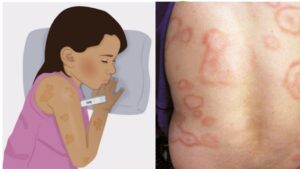Rheumatic Fever (Rheumatic Heart Disease) – Symptoms, Causes & Treatment
What Is Rheumatic Fever?
An uncommon yet possibly perilous illness, rheumatic fever is a complexity of untreated strep throat brought about by microbes called bunch A streptococcus. The primary side effects – – fever, muscle throbs, enlarged and difficult joints, and at times, a red, grid-like rash – – commonly start two to four weeks after an episode of strep. At times, however, the contamination might have been excessively gentle to have been perceived.

The knees, lower legs, elbows, and wrists are the joints probably going to become enlarged from rheumatic fever. The aggravation frequently relocates starting with one joint and then onto the next. Nonetheless, the most serious risk from the sickness is the harm it can do to the heart. In the greater part, everything being equal, rheumatic fever scars the valves of the heart, compelling this imperative organ to work harder to siphon blood. Over a time of months or even years – – especially on the off chance that the sickness strikes once more – – this harm to the heart can prompt a difficult condition known as rheumatic coronary illness, which can ultimately make the heart come up short.
Rheumatic fever can likewise cause a brief sensory system problem once known as St. Vitus’ dance, presently known as Sydenham’s chorea. This is an apprehensive problem – – portrayed by fast, jerky, compulsory developments of the body, typically happening more on one side of the body. Individuals with gentle instances of chorea might find it challenging to think or compose. More serious cases can cause the muscles of the arms, legs, or face to wildly jerk. It can likewise be related to muscle shortcomings and profound eruptions.
Due to anti-microbials, rheumatic fever is presently uncommon in evolved nations. Lately, however, it has started to get back in the saddle in the U.S., especially among youngsters living in poor, ghetto areas. The sickness will in general strike most frequently in cool, clammy climates throughout the colder time of year and late winter. In the U.S., it is most normal in the northern states.
What Causes Rheumatic Fever?
Rheumatic fever results from a provocative response to a specific gathering of A streptococcus microscopic organisms. The body produces antibodies to battle the microbes, however, rather the antibodies assault an alternate objective: the body’s own tissues. The antibodies start with the joints and frequently continue on toward the heart and encompassing tissues. Since just a little part (less than 0.3%) of individuals with strep throat at any point contract rheumatic fever, clinical specialists say that different elements, like a debilitated resistant framework, should likewise be engaged with the improvement of the illness.
What are the symptoms of rheumatic fever?
Rheumatic fever is made by a response to the bacterium that causes strep throat. Albeit not all instances of strep throat bring about rheumatic fever, this serious intricacy might be forestalled with a specialist’s determination and treatment of strep throat.
In the event that your or your kid has a sensitive throat alongside any of the accompanying side effects, see your PCP for an assessment:
- delicate and enlarged lymph hubs
red rash
trouble gulping
thick, ridiculous release from the nose
the temperature of 101°F (38.3°C) or above
tonsils that are red and enlarged
tonsils with white patches or discharge
little, red spots on the top of the mouth
cerebral pain
sickness
regurgitating
A wide assortment of side effects is related to rheumatic fever. An individual with the sickness could encounter a couple, some, or a large portion of the accompanying side effects. Side effects as a rule seem two to about a month after your youngster has a strep disease.
Normal side effects of rheumatic fever include:
little, easy knobs under the skin
chest torment
quick vacillating or beating chest palpitations
dormancy or weakness
nosebleeds
stomach torment
excruciating or sore joints in the wrists, elbows, knees, and lower legs
torment in one joint that moves to another joint
red, hot, enlarged joints
windedness
fever
perspiring
regurgitating
a level, somewhat raised, battered rash
jerky, wild developments of the hands, feet, and face
a decline in capacity to focus
eruptions of crying or improper giggling
What Treatments are powerful against rheumatic fever?
Treatment will include disposing of all of the remaining gatherings A strep microbes and treating and controlling the side effects. This can incorporate any of the accompanyings:
Anti-infection agents
Your youngster’s primary care physician will recommend anti-microbials and could endorse a drawn-out treatment to keep it from happening once more. In uncommon cases, your kid might get long-lasting anti-microbial treatment.
Mitigating treatment
Mitigating medicines incorporate torment drugs that are additionally calming, like ibuprofen (Bayer) or naproxen (Aleve, Naprosyn). However headache medicine use in youngsters with specific ailments has been related to Reye’s Disorder, the advantages of involving it in treating rheumatic fever might offset the dangers. Specialists may likewise recommend a corticosteroid to lessen the irritation.
Anticonvulsant prescriptions
Your youngster’s primary care physician could endorse an anticonvulsant on the off chance that compulsory developments become excessively extreme.
Bed rest
Your youngster’s PCP will likewise suggest bed rest and limited exercises until the significant side effects — like torment and irritation — have passed. Severe bed rest will be prescribed for half a month to a couple of months in the event that the fever has caused heart issues.

